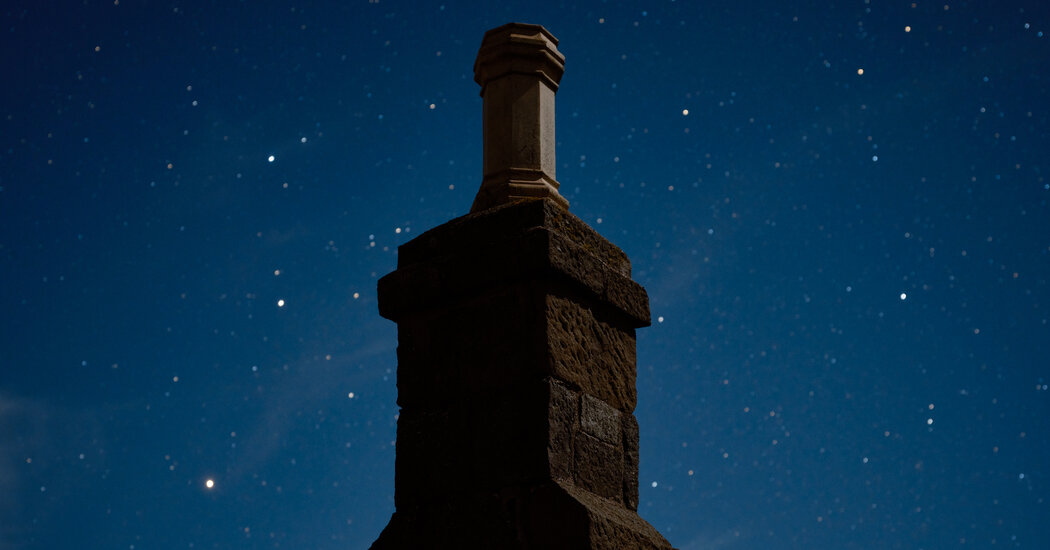Rum, a diamond-shaped island off the western coast of Scotland, is home to 40 people. Most of the island — 40 square miles of mountains, peatland and heath — is a national nature reserve, with residents mainly nestled around Kinloch Bay to the east. What the Isle of Rum lacks is artificial illumination. There are no streetlights, light-flooded sports fields, neon signs, industrial sites or anything else casting a glow against the night sky. On a cold January day, the sun sets early and rises late, yielding to a blackness that envelopes the island, a blackness so deep that the light of stars manifests suddenly at dusk and the glow of the moon is bright enough to navigate by.
For this reason, Rum was recently named Europe’s newest dark-sky sanctuary, a status that DarkSky International, a nonprofit organization focused on reducing light pollution, has granted to only 22 other places in the world. With the ever-increasing use of artificial lighting at night, places where people can gaze at the deep, ancient light of the universe are increasingly rare. Rum’s designation is the result of a long, meticulous bid by the Isle of Rum Community Trust. The effort was led by Alex Mumford, the island’s former tourism manager, and Lesley Watt, Rum’s reserve officer, with the support of Steven Gray and James Green, two astronomers who started Cosmos Planetarium, a mobile theater offering immersive virtual tours of the night sky. Rum “stands for something greater,” Mr. Mumford said, and aspires to be “a haven for others to experience the darkness and the Milky Way.”
A seven-mile walk from Kinloch through the wild and empty heart of the island leads to a Greek-style mausoleum, built in the 19th century, above Harris Bay on the west side of Rum. Locals regard it as the best spot on the island to take in the night sky; on a cloudy night with no moon, one resident said, “you can’t even see your hand in front of your face.” But this night was clear, and stars and meteors wheeled spectacularly overhead as the Milky Way drew a glistening smudge above the brooding mountains, Askival and Hallival. Venus, Saturn and Jupiter stood in a line above the mausoleum’s sandstone pillars.
Plans are in motion to renovate an abandoned lodge nearby into a place where tourists could stay in their quest for celestial splendor. “What you are seeing is not just a 2-D map, but the four dimensions of space and time,” Dr. Green said. “You are looking back into the past.”
A waxing gibbous moon lit the walk back along a trail that wound below the jagged peaks of the Rum Cuillin. Vega, one of the brightest stars in the night sky, shone above the horizon, brilliant against the blackness. Astronomers measure the darkness of the night sky with a device called a sky quality meter, and measurements taken monthly for two years put the night-sky’s brightness on Rum above 21, the magic number for dark sky observation on a scale that runs from 1 to 22. By the end of 2024, measurements at Harris were approaching 21.9, about as dark as it gets. This equates to a 1 (out of 9) on the Bortle scale, a numerical rating of night sky brightness; the average suburban sky is a 5.
On Rum, human life is lived in the small pools of light that spill from windows or glow from headlamps. One key to attaining dark-sky sanctuary status has been to help residents adapt to and embrace the darkness. Porch lights are recessed into doorways and point down; the pier has LED lights, also pointing downward, that provide just enough illumination for marine safety; a shop’s outdoor motion-sensor lights come on only for a few minutes when needed. When the community trust started its sanctuary application in 2022, roughly 15 percent of homes and shops followed the lighting recommendations outlined by the initiative; compliance is now at 95 percent.
The blackness of night provides more than a cosmic spectacle for humans to enjoy; it is also essential for the environment. “Low light levels are important for nocturnal species,” Ms. Watt said. “And artificial lighting can influence the feeding, breeding and migration behavior of many wild animals.”
In the spring and summer, the island is home to a large colony of nesting Manx shearwater, around a quarter of the seabird’s global population. As adult birds return to sandy burrows after wintering in South America, and as fledglings take to the wing in September, they are particularly prone to becoming disoriented by artificial light. Signs on Rum and in Mallaig, the harbor town on the mainland from which the ferry to the isle departs, remind people to turn off lights to protect the birds.
Education — of adults and children, locals and tourists — is central to dark-sky awareness. Andy McCallum, a teacher on Rum, showed off the models and maps of stars and planets that his handful of students had designed.
“For our pupils, it’s a powerful reminder that although we live on a small island, we’re part of a vast and interconnected universe,” he said. It made them proud, he added, to help preserve a unique environment for future generations. Catherine Heymans, an astrophysicist at the University of Edinburgh and the astronomer royal for Scotland, has championed Rum’s bid for a dark-sky status. Dark skies “are part of nature and what it means to be human,” she said.
In January, at an official celebration of the island’s dark-sky status, grown-ups stepped inside the mobile planetarium and explored the night sky. Mr. McCallum’s students were there, too, chatting excitedly about the constellations they knew and the dark skies they had seen. As one said, “It’s amazing to see so much in the sky and feel like you’re part of it.”
Checkout latest world news below links :
World News || Latest News || U.S. News
The post Embracing Darkness on the Isle of Rum appeared first on WorldNewsEra.

